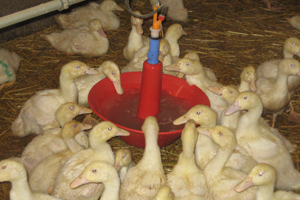Animal friendly watering system for Pekin ducks

Ducks have a high affinity with water. Providing water via nipple drinkers meets their need for drinking water but not their natural behaviour like straining, beak cleaning, cleaning of nostrils and eyes as well as the plumage. That raises the question whether modified round drinkers would be an appropriate welfare friendly alternative watering system.
By Wiebe van der Sluis
The drinking water supply of Pekin ducks is currently provided via nipple drinkers. There are no legally binding guidelines concerning construction, form or number of the used drinking systems for waterfowl neither in Germany, nor in the EU. The Standing Committee of the European Convention for the Protection of Animals Kept for Farming Purposes (1999), requires that ducks with no access to bathing water must be provided with water resources that allow them to take in water with their beaks, to put their heads under water and to splash water over their bodies freely. For ducks, having a high affinity with water, open drinking systems must be seen as an enrichment of their environment.
Since 2003 a group of German researchers tested various drinking systems which allow ducks to plunge their heads and to sprinkle water on their plumage. Dr Heyn Elke of the Department of Veterinary Sciences, Chair of Animal Welfare, Ethology, Animal Hygiene and Animal Husbandry at the Faculty of Veterinary Medicine of the Ludwig-Maximilians-University in Munich, Germany presented the results of the study at the recently held World Poultry Congress in Salvador, Brazil. He told that during pre-tests with ten fattening periods (1,152 Cherry Valley Pekin Ducks each), reared on the ground in six compartments with deep litter, the modified round drinker proved to be an appropriate water supply for Pekin ducks. This was reason to study the drinker under field conditions at three farms with a herd size from 7,100 – 13,500 birds. Control trials (solely customary nipples) and test trials (additional offering of round drinkers) alternated on the farms.
Field trials
In all operations, Cherry Valley Pekin ducks were fattened for the period of 37 to 47 days in cage-free husbandry with straw bedding in windowed houses. In each case a modified round drinking system was installed on the incline side of the houses. In addition to the nipple drinking system, the ducks in the test trials had access to these round drinkers for a daily time period of six hours, starting from the 25thday of life. The round drinker ‘AquaDuc T’ made by Big Dutchman International had a diameter of 45.3 cm (trough side length 142 cm). A spring integrated in the overhead suspension regulated the flow of water and thus the water level at 8-10 cm.
The behaviour of the ducks in the drinking areas was documented for 24-40 hours during each visit and more than 6,000 hours of video material were evaluated using Scan Sampling and Instantaneous Sampling. In order to evaluate the water associated health parameters, 100 animals (8,300 ducks in total) were examined for plumage quality, the degree of soiling on the plumage and obstruction of the nostrils, patency of the nasal cavity, eye infections, foot pad hyperkeratosis and necrosis during each visit. Also the levels of dust and ammonia were measured and the different types of drinking troughs were sampled (drip pans, nipple drinkers, round drinkers) in regard to total germ count and the number of Enterobacteriaceae.
Preference for modified round drinker
The results concerning animal behaviour, health and hygiene of drinking water confirmed the results of the pre-test. All results show that Pekin ducks clearly preferred the modified round drinkers ‘AquaDuc T’ over the nipple drinkers. They allow the animals to dunk their heads, to drink and strain the water in a species appropriate manner, to groom their plumage with water and to clean their beaks and eyes.
During the testing phase, the drinking activity (‘drinking’ and ‘cleaning in the drinking area’) increased significantly (p<0.001) up to 90% during the period of access to the round drinkers, whereas the nipple drinkers were used less during this period and considerably fewer animals rested. After the round drinkers were raised, the activity level at the nipple drinkers on this side increased. On the side of the nipple drinkers, the lowering of the round drinkers had no influence on the behaviour of the ducks. During the course of the fattening, drinking behaviour increased in all trials. A modified form of bathing behaviour could be observed at the round drinkers where ducks scooped water onto their plumage with their heads, and then interrupted this routine to clean their plumage.
Also, with respect to health, ducks with access to round drinkers almost always scored significantly better (p<0.05). The ducks in the test trials had cleaner plumage, less obstructions of the nostrils and patency of the nasal cavity and fewer eye infections than the animals that solely had access to nipple drinkers.
The evaluation of the feet revealed a pad hyperkeratosis rate in excess of 80%. On the whole, it was not possible to record a significantly higher or lower hyperkeratosis rate during test visits. In contrast, the evaluation “necrosis on feet” depends on the type of visit. The likelihood of the evaluation “no necrosis on feet” decreased on all three farms during test runs. On two farms the likelihood decreased significantly (p<0.05). The reasons for the appearance of foot pad dermatitis are complex. The two most likely causes are moist litter and a lack of biotin. Therefore, it is essential to ensure that there is good water drainage in the barn, when installing round drinkers. However there is still a need for further research.
Improvement of the environment
The quantitative study of the average total germ count and number of Enterobacteriaceae showed that the nipple drinking system performed best, with a total germ count of 10.950 ± 1.583 CFU/ml (n = 226) and an Enterobacteriaceae number of 113 ± 30 CFU/ml (n = 187). In the case of the round drinkers, a total germ count of 3.955.864 ± 877.640 CFU/ml (n = 40) and an Enterobacteriaceae number of 14.763 ± 2.459 CFU/ml (n = 33) were detected. The worst result was achieved by the drip pans, as they were frequently contaminated with feed residues, feathers and dust particles. The total germ count here was revealed to be 5.174.412 ± 564.137 CFU/ml (n = 62) while the Enterobacteriaceae number was 47.301 ± 11,057 CFU/ml (n = 44).
With regard to the germ counts it has to be noticed that the total germ counts of the drip pans, that are still existent in duck farming were significantly higher than in round drinkers. The general argument that the use of open water drinking systems is detrimental to animal welfare and health therefore cannot be confirmed. This study showed, as Dr Elke concluded, that the modified round drinker is accepted well by ducks and represents a considerable improvement of their environment. These drinkers allow the duck’s specific drinking and straining, beak cleaning, cleaning of nostrils and eyes as well as the plumage, which is reflected by a high activity at the drinkers.












